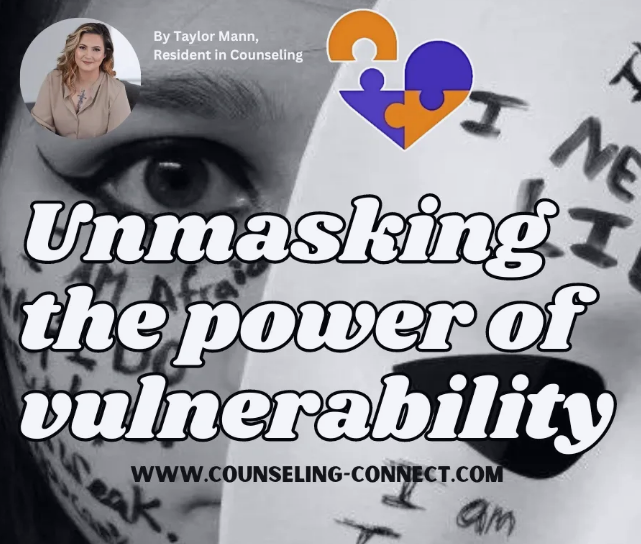By: Taylor Mann, Resident in Counseling
Defining Vulnerability:
Vulnerability is often misconstrued as a weakness, but in reality, it is the cornerstone of authentic human connection. As aptly stated by Lisa Fritscher (2023):
Although building walls creates a safe space into which you can quickly retreat, it also blocks the flow of energy and love. It’s easy to become trapped behind your own emotional defenses, unable to give or receive positive emotions as well as negative ones. This leaves many people feeling isolated and alone.
At its core, vulnerability is the raw and unfiltered essence of being human.
Examples of Vulnerability:
Consider moments when individuals openly share their fears, insecurities, or past struggles with trusted friends or family members. These instances, where emotional guards are temporarily lowered, exemplify vulnerability. It can also manifest in expressing genuine emotions, such as crying in front of someone or admitting mistakes without fear of judgment. These moments of self-disclosure increase closeness, especially when the disclosure is reciprocated.
The Impact of Vulnerability on Mental Well-being:
Vulnerability significantly influences an individual’s mental well-being. It’s essential forauthentic connection, like the sense of relief and support felt when confiding in a close friend about personal challenges. Human beings have a physiological need for love and belongingness(Brown, 2012). When that need is unmet, it leads to emotional, mental, and physical distress. The fear of vulnerability and avoidance of intimacy hinders interpersonal relationships, causing feelings of disconnection and isolation.
Vulnerability in Relationships:
When we open up to others, we run the risk of getting hurt. “Being vulnerable is the ultimate act of courage,” (Brown, 2015). In healthy relationships, vulnerability acts as the glue that binds individuals together. For instance, sharing personal hopes and fears with a romantic partner can deepen emotional intimacy. On the flip side, the reluctance to be vulnerable may result in surface-level connections, such as avoiding open communication or withholding emotions.
Navigating Vulnerability in Personal Growth:
Embracing vulnerability is pivotal for personal growth. Consider someone seeking therapy to discuss past traumas or challenges. Allowing oneself to be vulnerable in a therapeutic setting opens the door to self-discovery, resilience, and a more profound understanding of one’s own emotions.
The Difficulty of Vulnerability in Survival Mode:
Acknowledge that being constantly in survival mode or within a chaotic environment makes vulnerability challenging. For example, individuals who have faced consistent adversity may find it difficult to let down their guard due to past experiences of vulnerability leading to negative outcomes. However, resisting self-sabotage is crucial to living authentically and breaking free from limiting patterns.
We have a tendency to retreat when we’ve been hurt or traumatized. This may result in someone shutting off or numbing their feelings. Unfortunately, this is an ineffective way to cope. In the words of Brene Brown (2011):
You cannot selectively numb emotion. You can’t say, here’s the bad stuff. Here’s vulnerability, here’s grief, here’s shame, here’s fear, here’s disappointment. I don’t want to feel these… So when we numb those, we numb joy, we numb gratitude, we numb happiness. And then, we are miserable, and we are looking for purpose and meaning, and then we feel vulnerable, so then we have a couple of beers and a banana nut muffin. And it becomes this dangerous cycle.
The way to break this is cycle to establish safety and engage in deep, meaningful emotional bonds with other people. The root of those bonds is vulnerability. In essence, we are hurt by people and also healed by people.
Sources: [Verywell Mind – Fear of Vulnerability](https://www.verywellmind.com/fear-of-vulnerability-2671820)*
Brown, B. (2012). Daring greatly: How the courage to be vulnerable transforms the way we live, love, parent, and lead. New York, NY: Gotham Books.
Brown, B. (2011). The power of vulnerability. TED Talks. https://www.youtube.com/watch?v=iCvmsMzlF7o

